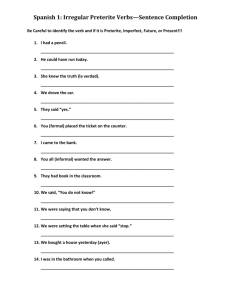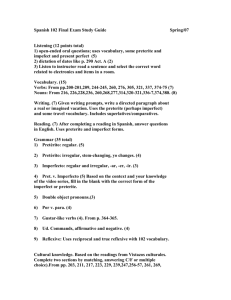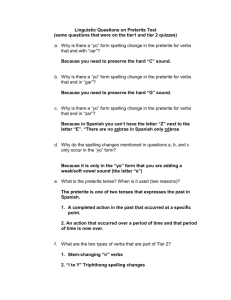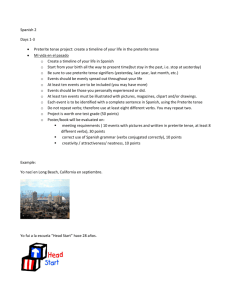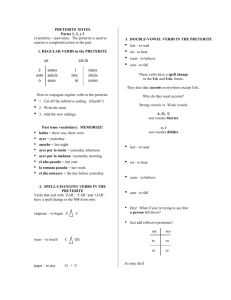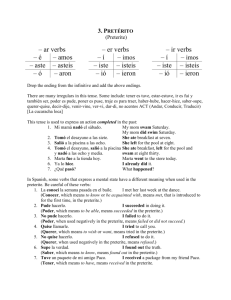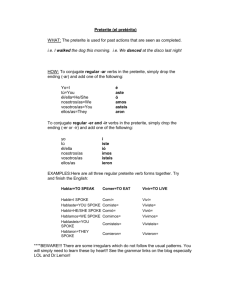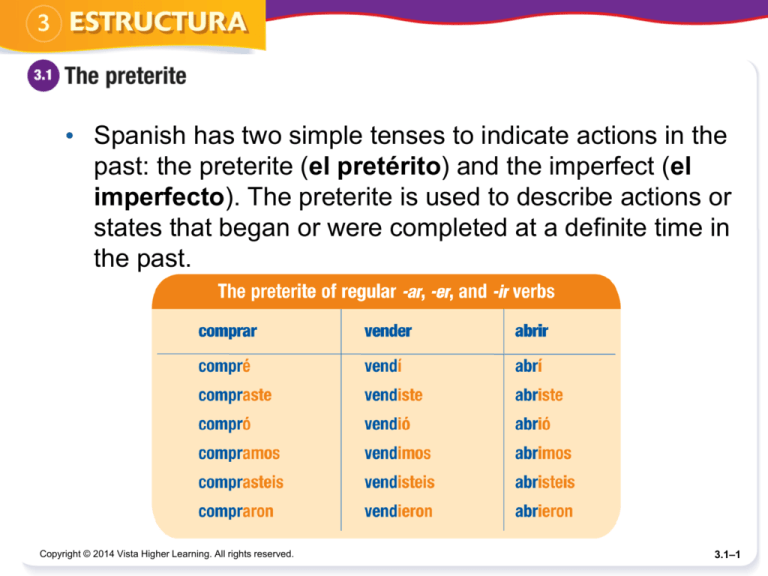
• Spanish has two simple tenses to indicate actions in the
past: the preterite (el pretérito) and the imperfect (el
imperfecto). The preterite is used to describe actions or
states that began or were completed at a definite time in
the past.
Copyright © 2014 Vista Higher Learning. All rights reserved.
3.1–1
• The preterite tense of regular verbs is formed by
dropping the infinitive ending (–ar, –er, –ir) and adding
the preterite endings. Note that the endings of regular
–er and –ir verbs are identical in the preterite tense.
• The preterite of all regular and some irregular verbs
requires a written accent on the preterite endings in the
yo, usted, él, and ella forms.
Ayer empecé un nuevo trabajo.
Mi mamá preparó una cena
deliciosa.
Yesterday I started a new job.
My mom prepared a delicious
dinner.
Copyright © 2014 Vista Higher Learning. All rights reserved.
3.1–2
• Verbs that end in –car, –gar, and –zar have a
spelling change in the yo form of the
preterite. All other forms are regular.
Copyright © 2014 Vista Higher Learning. All rights reserved.
3.1–3
• Caer, creer, leer, and oír change –i– to –y– in
the third-person forms (usted, él, and ella forms
and ustedes, ellos, and ellas forms) of the
preterite. They also require a written accent on
the –i– in all other forms.
Copyright © 2014 Vista Higher Learning. All rights reserved.
3.1–4
• Verbs with infinitives ending in –uir change –i–
to –y– in the third-person forms of the preterite.
Copyright © 2014 Vista Higher Learning. All rights reserved.
3.1–5
• Stem-changing –ir verbs also have a stem
change in the third-person forms of the
preterite. Stem-changing –ar and –er verbs
do not have a stem change in the preterite.
Copyright © 2014 Vista Higher Learning. All rights reserved.
3.1–6
Other –ir stem-changing verbs include:
conseguir
repetir
consentir
seguir
hervir
sentir
morir
servir
preferir
Copyright © 2014 Vista Higher Learning. All rights reserved.
3.1–7
• A number of –er and –ir verbs have irregular
preterite stems. Note that none of these verbs
takes a written accent on the preterite endings.
Copyright © 2014 Vista Higher Learning. All rights reserved.
3.1–8
Copyright © 2014 Vista Higher Learning. All rights reserved.
3.1–9
• Note that the stem of decir (dij–) not only
ends in j, but the stem vowel e changes to i.
In the usted, él, and ella form of hacer (hizo),
c changes to z to maintain the pronunciation.
Most verbs that end in –cir have j-stems in
the preterite.
Copyright © 2014 Vista Higher Learning. All rights reserved.
3.1–10
Ser, ir, dar, and ver also have irregular preterites. The preterite
forms of ser and ir are identical.
ser/ir
fui, fuiste, fue, fuimos,
fuisteis, fueron
ver
vi, viste, vio, vimos,
visteis, vieron
dar
di, diste, dio, dimos,
disteis, dieron
Copyright © 2014 Vista Higher Learning. All rights reserved.
3.1–11
(continued)
The preterite of hay is hubo.
Hubo dos conciertos el viernes.
There were two concerts on Friday.
Copyright © 2014 Vista Higher Learning. All rights reserved.
3.1–12

